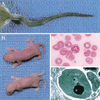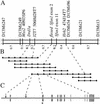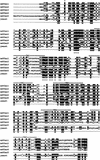A mutation in a mitochondrial transmembrane protein is responsible for the pleiotropic hematological and skeletal phenotype of flexed-tail (f/f) mice
- PMID: 11274051
- PMCID: PMC312659
- DOI: 10.1101/gad.873001
A mutation in a mitochondrial transmembrane protein is responsible for the pleiotropic hematological and skeletal phenotype of flexed-tail (f/f) mice
Abstract
We have studied the flexed-tail (f) mouse to gain insight into mammalian mitochondrial iron metabolism. Flexed-tail animals have axial skeletal abnormalities and a transient embryonic and neonatal anemia characterized by pathologic intramitochondrial iron deposits in erythrocytes. Mitochondrial iron accumulation is the hallmark of sideroblastic anemias, which typically result from defects in heme biosynthesis or other pathways that lead to abnormal erythroid mitochondrial iron utilization. To clone the f gene, we used positional cloning techniques, and identified a frameshift mutation in a mitochondrial transmembrane protein. The mutated gene, Sfxn1, is the prototype of a novel family of evolutionarily conserved proteins present in eukaryotes.
Figures





References
-
- Andrews NC. Iron homeostasis: Insights from genetics and animal models. Nat Rev (Genetics) 2000;1:208–217. - PubMed
-
- Azzi A, Glerum M, Koller R, Mertens W, Spycher S. The mitochondrial tricarboxylate carrier. J Bioenerg Biomem. 1993;25:515–524. - PubMed
-
- Bateman AE, Cole RJ. Colony forming cells in the livers of prenatal flexed (f/f) anaemic mice. Cell Tissue Kinet. 1972;5:165–173. - PubMed
-
- Bekri S, Kispal G, Lange H, Fitzsimons E, Tolmie J, Lill R, Bishop DF. Human ABC7 transporter: Gene structure and mutation causing X-linked sideroblastic anemia with ataxia with disruption of cytosolic iron–sulfur protein maturation. Blood. 2000;96:3256–3264. - PubMed
-
- Bottomley SS. Sideroblastic Anemias. In: Lee GR, editor. Wintrobe's clinical hematology. Baltimore: Williams and Wilkins; 1999. pp. 1022–1045.
Publication types
MeSH terms
Substances
Grants and funding
LinkOut - more resources
Full Text Sources
Other Literature Sources
Molecular Biology Databases
Research Materials
